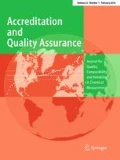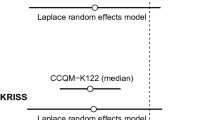Abstract
Uncertainties occur at all stages of a measurement process. Quantification of these uncertainties is important in order to make reliable decisions based on these measurement results. In some cases it can be useful to be able to compare the uncertainties associated with different measurement methods, in order to establish the method that is most reliable. A comparison can also be made between uncertainties that have themselves been evaluated using different estimation procedures. This paper discusses the comparison of uncertainties in chemical measurements using case study examples. Depending on the context, both exact and approximate F-tests are used to compare the ratios of uncertainties, while in some cases the approach is to compare separate confidence intervals.





Similar content being viewed by others
References
Ellison SLR, Williams A (Eds.) Eurachem/CITAC guide: Quantifying uncertainty in analytical measurement, Third edition, (2012) ISBN 978–0–948926–30–3 https://www.eurachem.org/index.php/publications/guides/quam
International Organization for Standardization. ISO/IEC Guide 98–4:2012(en) Uncertainty of measurement — Part 4: Role of measurement uncertainty in conformity assessment. ISO: Geneva, Switzerland https://bbn.isolutions.iso.org/obp/ui#iso:std:iso-iec:guide:98:-4:ed-1:v1:en
International Organization for Standardization. ISO/IEC Guide 98–3:2008(en) Uncertainty of measurement - Part 3: Guide to the expression of uncertainty in measurement (GUM:1995) . ISO: Geneva, Switzerland https://bbn.isolutions.iso.org/obp/ui#iso:std:iso-iec:guide:98:-3:ed-1:v2:en5
International Organization for Standardization. ISO/IEC Guide 99:2007(en) International vocabulary of metrology — Basic and general concepts and associated terms (VIM). ISO: Geneva, Switzerland https://bbn.isolutions.iso.org/obp/ui#iso:std:iso-iec:guide:99:ed-1:v2:en
Ramsey MH, Ellison SLR, Rostron PD (Eds.) (2019) Eurachem/EUROLAB/ CITAC/Nordtest/AMC Guide: measurement uncertainty arising from sampling: a guide to methods and approaches. Second Edition, Eurachem. ISBN (978–0–948926–35–8) https://www.eurachem.org/index.php/publications/guides/musamp
Lyn JA, Ramsey MH, Coad S, Damant AP, Wood R, Boon KA (2007) The duplicate method of uncertainty estimation: Are eight targets enough? Analyst 132:1147–1152
AMC (1989) Robust statistics - how not to reject outliers. Part1, basic concepts. Analyst 114:1693–1697
AMC (2020) RANOVA3 computer program https://www.rsc.org/membership-and-community/connect-with-others/through-interests/divisions/analytical/amc/software/
Rostron PD, Fearn T, Ramsey MH (2020) Confidence intervals for robust estimates of measurement uncertainty. Accred Qual Assur 25:107–119
Schenker N, Gentleman JF (2001) On judging the significance of differences by examining the overlap between confidence intervals. Am Stat 55(3):182–186
Horwitz W (1990) Nomenclature for sampling in analytical chemistry (Recommendations 1990) International Union for Pure and Applied Chemistry. Pure Appl Chem 62:1193–1208
Rostron PD, Ramsey MH (2017) Quantifying heterogeneity of small test portion masses of geological reference materials by PXRF: implications for uncertainty of reference values. Geostand Geoanal Res 41(3):459–473
Webb PC, Thompson M, Potts PJ, Wilson SA (2014) GeoPT35A — An international proficiency test for analytical geochemistry laboratories — Report on supplementary round 35A (metalliferous sediment, SdAR-H1) https://www.google.com/search?client=firefox-b-d&q=GeoPT35AReport.pdf
Ramsey MH, Wiedenbeck M (2017) Quantifying isotopic heterogeneity of candidate reference materials at the picogram sampling scale. Geostandards Geoanal Res 42(1):5–24
Jean OJ (1961) Multiple comparisons among means. J Am Stat Assoc 56(293):52–64
Ramsey MH, Geelhoed B, Wood R, Damant AP (2011) Improved evaluation of measurement uncertainty from sampling by inclusion of between-sampler bias using sampling proficiency testing. Analyst 136:1313–1321
Thompson M, Fearn T (1996) What exactly is fitness for purpose in analytical measurement? Analyst 121:275–278
Author information
Authors and Affiliations
Corresponding author
Additional information
Publisher's Note
Springer Nature remains neutral with regard to jurisdictional claims in published maps and institutional affiliations.
Based upon a presentation by the first author at the EURACHEM Workshop ‘Uncertainty from sampling and analysis for accredited laboratories’, November 2019, Berlin, Germany.
Rights and permissions
About this article
Cite this article
Rostron, P.D., Fearn, T. & Ramsey, M.H. Comparing uncertainties—Are they really different?. Accred Qual Assur 27, 133–142 (2022). https://doi.org/10.1007/s00769-022-01501-2
Received:
Accepted:
Published:
Issue Date:
DOI: https://doi.org/10.1007/s00769-022-01501-2



